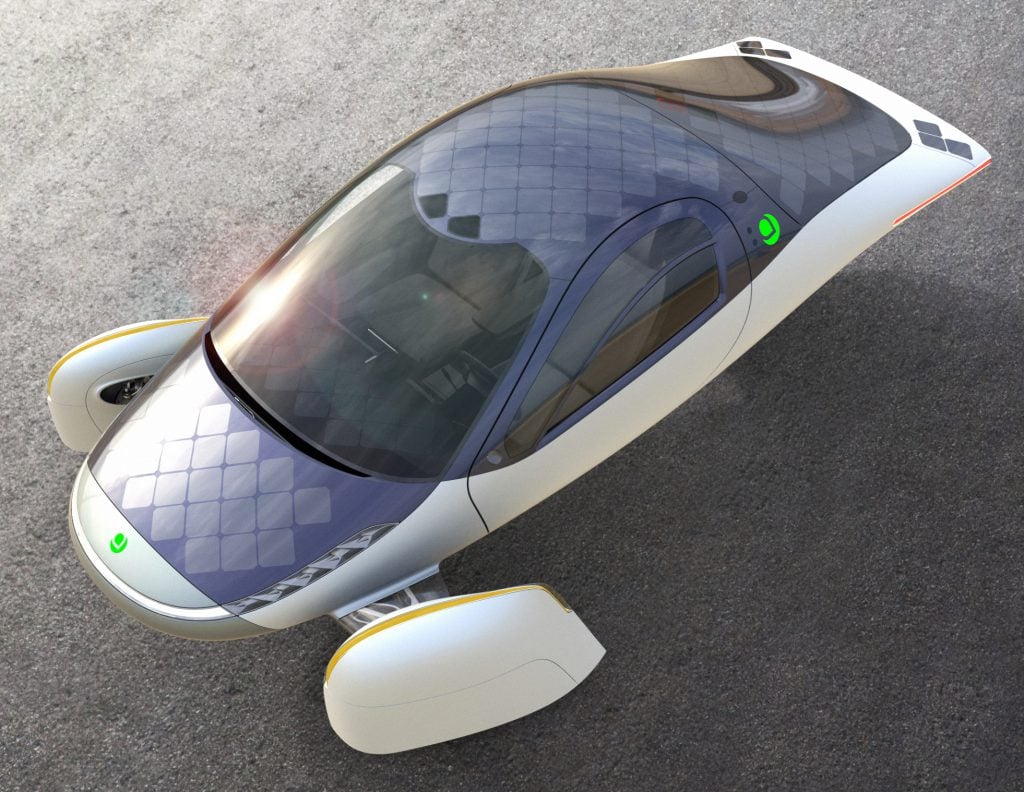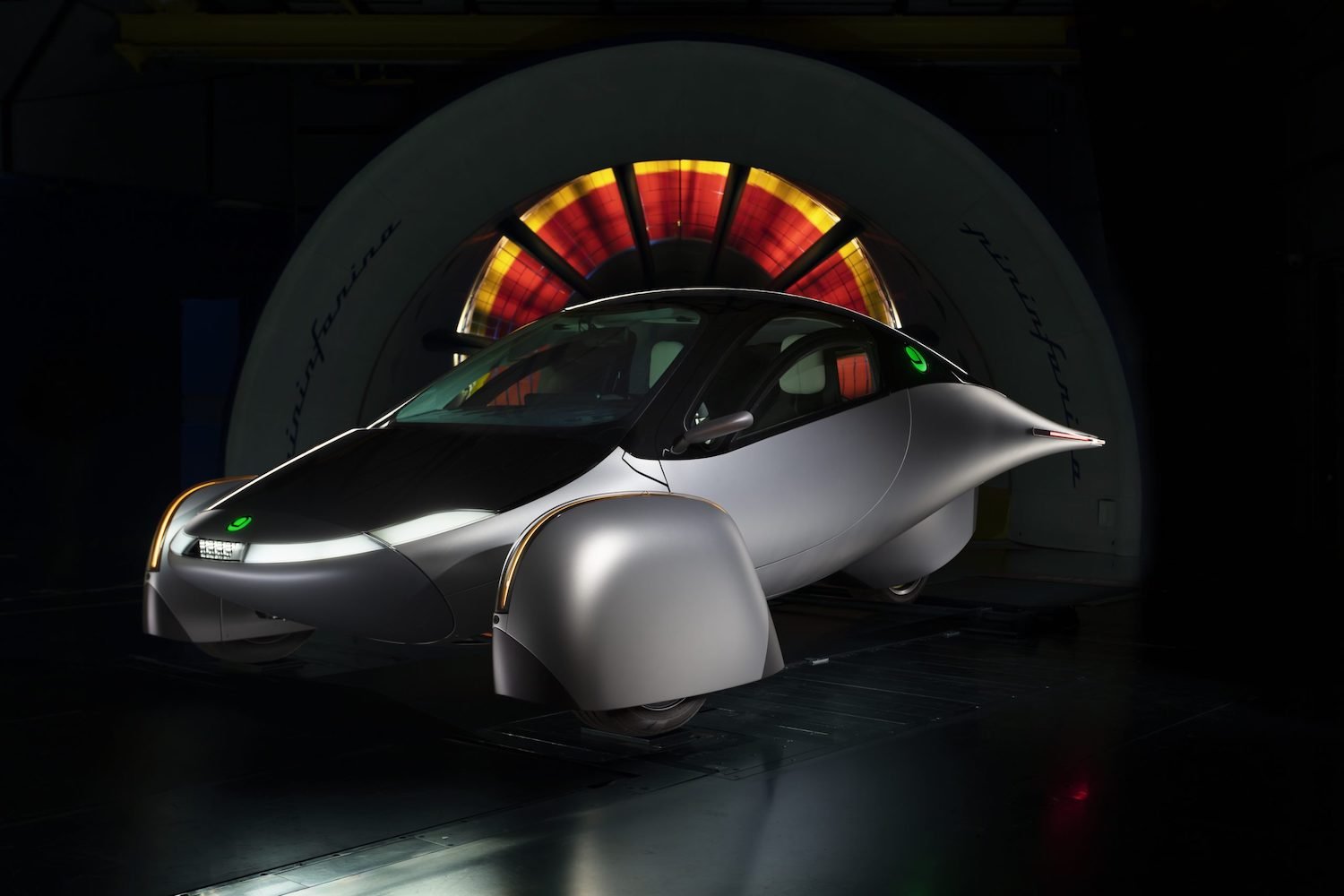Picture this: You’re cruising to Las Vegas, bopping in and out of the HOV lane as you please, fueled by sunshine.
If this sounds like a good time, the three-wheeled electric vehicle from Carlsbad-based company Aptera might be your huckleberry. While it’s technically a motorcycle (hence the HOV access), its size and strong carbon fiber frame make it far more similar to a car, drivable by anyone with a regular license.
The Aptera breezes through the 332-mile trip with ease. Its battery pack affords it 400 miles on a full charge, while its solar-powered skin draws on the sun to constantly top off the battery as you drive, no specialized charging stations necessary.
Aptera co-founder Chris Anthony modeled the vehicle after a shark—a key design choice in the company’s effort to create the most efficient car on the market. “Sharks swimming close to the sea floor figured out millions of years ago that if they developed a hump on their back, it sucks away a lot of the pressure that builds in front of their nose,” Anthony says.

Aptera paid the National Aeronautics and Space Administration to test the unique design with the same kind of supercomputer that tests rockets. Looking something akin to a hovercraft, the sloping shape allows air pressure to effortlessly flow over the surface of the vehicle, unlike the boxy nose of a traditional SUV barreling down the freeway.
“We found that out through computational fluid dynamics. We were like, ‘Oh, that’s what fish do, too,’” Anthony explains.
Sea creatures weren’t the lone muse for the vehicle. Some of Aptera’s inspiration comes from Italian supercars composed of a lightweight carbon fiber cage that Anthony says is many times stronger than steel. Formula 1 vehicles use a similar body.
I got the chance for a test spin in an earlier model and can confirm that this car is zippy, reaching 60 miles per hour in just a few seconds and hitting a top speed of 101 miles per hour. Its capacity for quickness is thanks to the simplicity of how electric motors work—and why vehicles driven by electricity came well before gas-powered ones back in the early 19th century. “The electric motor has only one moving part. The electric field spins the rotor connected to the wheels,” Anthony says.
Cars powered by gas, known as combustion vehicles have a lot of moving parts, including injectors and crank shafts. All that movement causes gas-powered vehicles to instantly lose a quarter of the energy from their fuel. Aptera’s mission is to strip down motors to the essentials, cutting weight and maximizing aerodynamics.

The back of Aptera’s two-seater is large enough to fit a sizable surfboard or convert into overnight shelter for outdoor adventures.
Their designs are more than a decade in the making. The business launched as Aptera Motors, Inc. in 2010. But it had trouble getting off the ground after a failed attempt to secure seed funding from the US Department of Energy initiative that helped jumpstart Tesla.
The fate of electric vehicles is much brighter now. The federal government recently relaunched that program, making billions of dollars available in direct loans under Congress’ Inflation Reduction Act. Aptera submitted another application and raised over $90 million via a crowdfunding campaign.
More than 45,000 people put $100 down to reserve an Aptera, Anthony says. The launch edition’s price starts at $33,200. Because costs go up depending on battery size and solar application, the total worth of Aptera’s pre-ordered cars is over $1.5 billion. The company hopes to produce its first vehicles by late 2024, depending on when it hits its funding milestones.
The car’s efficient design also streamlines the assembly process. Aptera’s one-room Carlsbad microfactory doesn’t look large enough to manufacture whole automobiles at first blush. A large blue line along the floor winds through the building, tracing the track each car will take down an automated assembly line powered by robots. The plan is to launch more microfactories wherever the highest density of orders are coming from.
Each microfactory will be able to produce 40 Apteras per day. The car’s six main components, including its carbon fiber body (which comes from CPC Group in Modena, Italy, a main manufacturer of supercars and motorcycles), arrive pre-assembled, so it’s just a matter of fusing them together, a process that takes less than two hours.
The company’s launch model is a two-seater with a ton of leg room. The motors are stored in the wheels. The car looks small in photos—and, to be honest, in real life, as well—but it’s about as long as a Prius and an inch wider than a Ford F-150 pickup truck.
Potential customers frequently ask Anthony whether the car is safe, a standard query for any new vehicle on the market. He reminds them that Aptera is using the same cage as a Formula 1 car, which is designed to race at speeds well over 150 miles per hour. The vehicle has airbags, safety belts, all the traditional fixings of a regular car, Anthony says.
PARTNER CONTENT
“But you can’t buy a car under half a million that has this type of carbon fiber technology,” he adds.
Back in Vegas, a simple extension cord and a wall outlet are enough to plug in your car so it can recharge while you explore the Strip. (Though it will be supercharger-compatible, in case you want to hit the road again more quickly.) Or, just park it and let the sun do the work.












